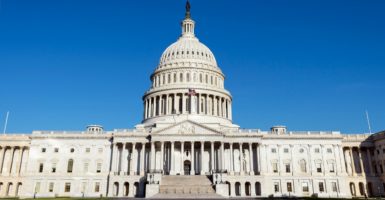In his final budget proposal, President Barack Obama proclaimed that the federal budget is “on a more sustainable fiscal path.”
This is simply not true.
Over the last two presidential administrations, total debt has grown considerably, along with the risk of a significant financial crisis. U.S. government debt now climbs above $19.5 trillion. When the next president takes office, publicly-held debt will be 73.6 percent of the U.S. economy.
The government has assumed more risky assets through loan guarantees and direct support of financial entities. And we now have a large share of the budget that has been growing faster than the economy for some time with no expectation that it will slow on its own.
The next president will likely be forced to confront these realities. Even if the bond markets do not force confrontation, he or she will have a responsibility to take the debt issue seriously. If not taken seriously, the systemic risk will only grow: the federal government is already over leveraged in health care, housing, education—three areas where we have some suspicion that there is a massive growing bubble.
When the financial crisis comes, it will come quickly. Interest rates will spike and bonds prices will tank, sending the economy into a deep recession. Economic foresight is difficult. The magnitude and catalyst of the next crisis is uncertain, but these fundamental conditions will perpetuate the crisis.
Critics of this idea maintain that high debt-to-gross domestic product ratios do not cause a systemic risk to the economy. They claim that no matter how high the national debt, the government can and will print money at no cost to keep interest rates low.
In the past this may have been true. But as the national debt swells, interest rates on federal financing are uncertain and liable to increase in a short amount of time with little warning regardless of what government forecasters, like the Congressional Budget Office, project.
When the financial crisis comes, it will come quickly. Interest rates will spike and bonds prices will tank, sending the economy into a deep recession.
With this grim forecast in mind, it is immoral to continue putting savers and future taxpayers at such risk. Lawmakers must make the hard choice to acknowledge that the national debt is unsustainable and address the underlying causes.
Many members of the GOP are still stuck in the Reagan era of budgeting. They believe that we can make the budget more sustainable by only reducing its size and scope, freeing the economy of regulation and cutting taxes, and growing our way out of the fiscal mess. At the same time, Democrats think we can ignore the budget by continually raising taxes to stabilize deficits as a percentage of the economy.
They are both wrong.
My recent research has found that the budget is currently made unsustainable by only 2 percent of all programs. While this problem seems negligible, those accounts make up 60 percent of total spending over the next 10 years. I show that we cannot grow or tax our way to sustainability if the growth in spending for those programs continues to exceed economic growth, as it has done historically.
In the United States, public health care expenditures are the primary driver of government spending growth. In 2015, total health care expenditures are at approximately 18 percent of GDP and will rise to 19.6 percent by 2024. Government pension and retirement funds also contribute to explosive spending and, like health care expenditures, these programs will not slow to sustainable spending levels on their own.
Controlling program spending growth is necessary. In the long run, unsustainable spending will have serious and negative implications for future fiscal choices. Postponing critical reforms to the underlying problems will only exacerbate these problems. But reducing program spending will not cure the federal government’s underlying ailments.
The next president and Congress must confront program spending that drives underlying unsustainability and addresses the government’s size and scope. The Heritage Foundation’s “Blueprint for Reform” provides one path to a comprehensive policy agenda for the next administration to do just that. But there are lots of viable options that all elected officials should be taking much more seriously.
Correcting the government’s fiscal path will be hard and fraught with political obstacles. Yet the longer it takes to reform the budget, the more significant the risk that lawmakers take with the wellbeing of future generations who are unable to defend their positions. Lawmakers must act now to eliminate unsustainable government spending and ensure freedom, choices, and opportunity in the future.

























